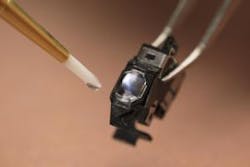Biocompatible, Nanosilica Filled LED Curable Adhesive
Master Bond LED405Med is a one component, LED curing adhesive system that meets ISO 10993-5 cytotoxicity requirements for use in medical device assembly. “Since this system does not need a UV light for curing it is intrinsically more user friendly”, says Rohit Ramnath, Senior Product Engineer. “LED405Med has a nanosilica filler resulting in both lower shrinkage upon cure, as well as greater dimensional stability with a coefficient of thermal expansion of 35-40 in/in x 10-6/°C. This product cures to a hardness of 65-75 Shore D, indicating that it is not too stiff, thereby offering good toughness.”
LED405Med is optically clear, with a refractive index of 1.50, and offers excellent light transmission properties. This electrically insulative system features a high volume resistivity of more than 1014 ohm-cm and a low dielectric constant of 4.2 at 60 Hz. It has good flowability with a viscosity of 2,000-8,000 cps and can be used for bonding, sealing and coating. LED405Med cures up to 0.125 inch thick and is suitable for small encapsulations involving optical assemblies or other sensitive components.
This no-mix system cures fully tack-free upon exposure to a 405 nm wavelength light source without any oxygen inhibition. In thinner sections, full cures can be achieved in 30-45 seconds. The rate of cure depends upon the intensity of the light source, the thickness of the adhesive layer and the distance from the light to the adhesive. LED405Med is serviceable from -60°F to +250°F and withstands gamma radiation as well as various chemical sterilants including EtO.
